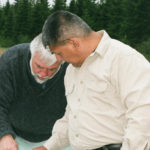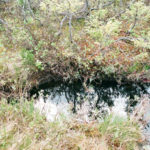 Bear sign was plentiful as the three of us struggled, slashed, and made our way through thick alder, spruce and swampy areas deep within the plateau of the Cape Breton Highlands.
Bear sign was plentiful as the three of us struggled, slashed, and made our way through thick alder, spruce and swampy areas deep within the plateau of the Cape Breton Highlands.
“That tells us we’re near the bogs we are looking for” noted Tony Nette of NS Dept of Natural Resources. “The bogs are ones that moose tend to get trapped in–often with no escape.”
Accompanying Nette were myself (Clifford Paul) and Mi’kmaq archaeologist Roger Lewis from Kwilmu’kw Maw-klusuaqn. The area leading to the bogs was unbelievably thick–not designed for human feet to slosh through–especially in mid-June when all the biting insects are very thirsty, moose are rearing their calves, and bear are nurturing their young.
Our mission was to photograph, search, and explore these bogs, to look for moose carcasses nearby, and to register the sites on Lewis’ handy GPS device. More importantly, and from an archaeological perspective, our goal was to see if there were ancient Mi’kmaq encampments and sites near these bogs. As a matter of interest, the 4500-year old arrowhead found in the Highlands was within close proximity of the bogs. Certainly, fresh kills there may have provided the ancient Mi’kmaq harvester an easy source of meat. Future visits, and perhaps some test digs, may yield the results we are looking for.
These bogs are six to ten feet deep. When a moose steps into one of the pools–that’s it! There is virtually no escape. The moose will only be able to use its front legs to escape, but evidence shows the attempts are futile as their sharp hooves just cut the peaty edge of the bog. The peat is not enough ground for the moose to climb out. They succumb to exhaustion and eventual drowning. Bears, coyotes, eagles, and other opportunists feed on the remains.
“We’ve known these have existed for some time. And one hunter came across these (floating) bogs and reported at least a dozen moose carcasses during last year’s hunt.” Nette explaned. “It is a very interesting natural phenomena. One thing we did learn in our excursion, is we didn’t see evidence of animals there in the spring. It is more likely an event that occurs in the late summer and fall.”
Should anyone come across similar bogs in the Cape Breton Highlands, please report the location to Clifford Paul, Unama’ki Institute of Natural Resources 902 379 2163 or email me: clifford@uinr.ca.
From UINR Marten – Vol.3. Issue.2 – Summer 2007


